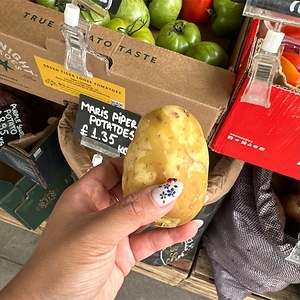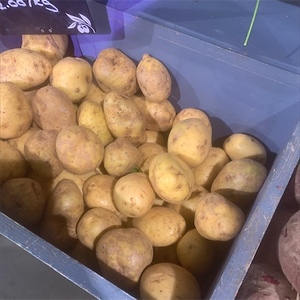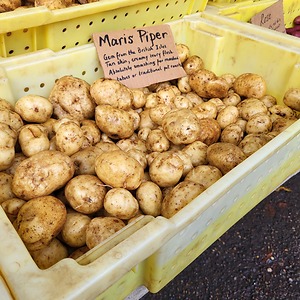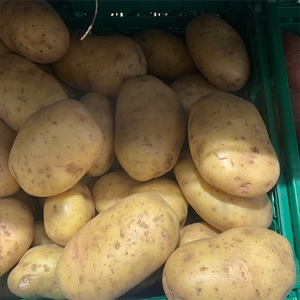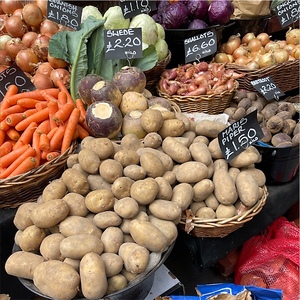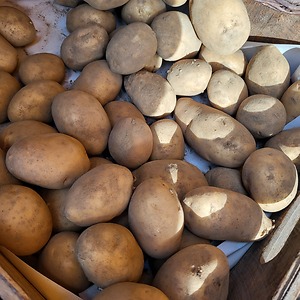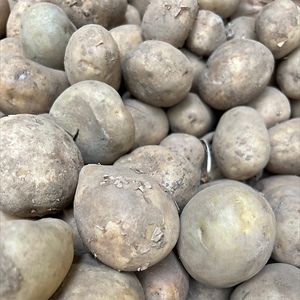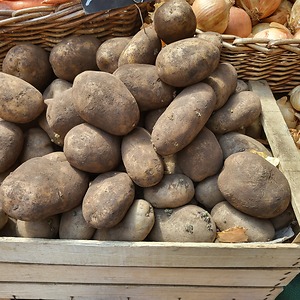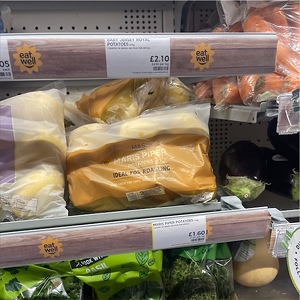

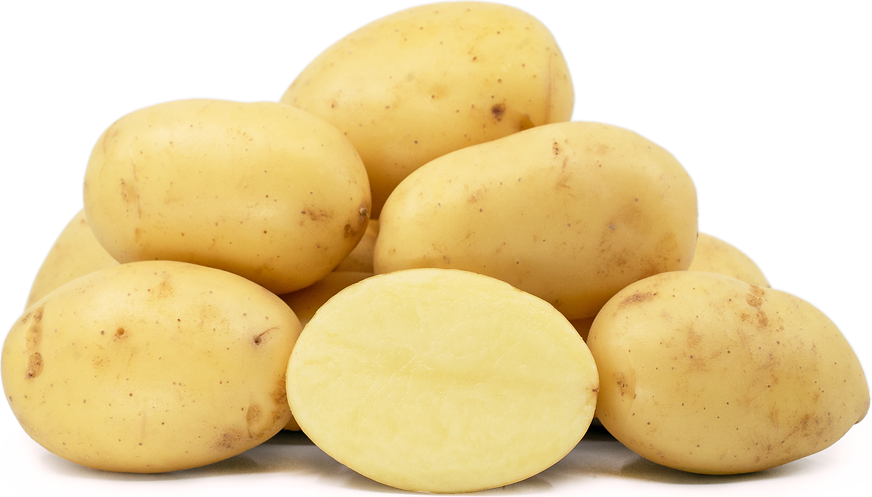
Maris Piper Potatoes
Estimated Inventory, lb : 0
Description/Taste
Maris Piper potatoes vary in size, depending on growing conditions, but are generally small to medium, averaging 3 to 5 centimeters in diameter. The variety is known for its uniform nature showcasing an oval to oblong shape with blunt, curved edges. The skin is thin, taut, and smooth, bearing only a few shallow eyes that do not affect the tuber’s appearance. The skin also has a golden yellow-brown exterior, sometimes covered in a few tiny dark brown spots and markings. Underneath the surface, the yellow to cream-colored flesh is dense, firm, and slippery when raw and contains a significant amount of dry matter. The potatoes must be cooked before they can be consumed and develop a light, fluffy, floury, and creamy consistency. The tubers also have the capacity to form a crisp and crunchy exterior when cooked in specific methods, providing a pleasant contrast with the soft flesh. Maris Piper potatoes are favored for their mild, subtly sweet, earthy, and light buttery taste.
Seasons/Availability
Maris Piper potatoes are typically harvested in the late summer through fall. Once picked, the variety can be professionally stored for several months, offering year-round availability.
Current Facts
Maris Piper potatoes, botanically classified as Solanum tuberosum, are a variety developed within the United Kingdom, belonging to the Solanaceae or nightshade family. The maincrop cultivar was commercially released in the mid to late 20th century and was initially selected for its pest and disease resistance. After its debut, Maris Piper potatoes quickly gained notoriety for their versatility in culinary preparations, becoming labeled as an “all-rounder” variety. Maris Piper potatoes eventually became one of the most commercially produced tubers in the United Kingdom and has remained a top cultivar into the modern day. Chefs and home cooks favor Maris Piper potatoes for their mild flavoring and ability to create a crisp, crunchy exterior and a soft, fluffy interior. When in season, Maris Piper potatoes are widely available throughout the United Kingdom and are offered fresh or in frozen, processed form. Maris Piper potatoes are also one of the few varieties in the United Kingdom that are directly named in recipes, further enforcing their popularity and unique culinary attributes.
Nutritional Value
Maris Piper potatoes have not been extensively studied for their nutritional properties and their vitamin and mineral content will vary based on the cooking method. Potatoes, in general, are a source of vitamin B6 to assist with everyday brain functions, fiber to regulate the digestive tract, vitamin C to strengthen the immune system, and potassium to balance fluid levels within the body. Potatoes also provide iron to develop the protein hemoglobin for oxygen transport through the bloodstream, magnesium to control nerve operations, calcium to support bones and teeth, and other nutrients, including thiamine, niacin, and riboflavin.
Applications
Maris Piper potatoes have a mild, subtly earthy, and sweet taste suited for cooked preparations. The variety is favored for its high starch content, also known as dry matter, allowing it to develop a crisp, crunchy exterior and a fluffy, light interior in select culinary preparations. Maris Piper potatoes are famous for their ability to be made into chips. In England, chips are another name for fries and are often served with national dishes such as fish and chips. Maris Piper potatoes are utilized by restaurants and home chefs for chips and are considered one of the best varieties for creating the crunchy and fluffy side dish. Maris Piper potatoes are also roasted into wedges, baked whole, or cooked into hashes with eggs, bacon, and sausages. In addition to its high starch content, the variety holds its shape well, being used in potato salads, gratins, soups, stews, and curries. Throughout the United Kingdom, Maris Piper potatoes are incorporated into various savory pies, including cottage, fish, and shepherds. The tubers also create a soft and fluffy mash, added to bubble and squeak, a dish of potatoes and vegetables. Maris Piper potatoes are a versatile variety and can be used in any recipe calling for an all-rounder tuber. Maris Piper potatoes pair well with spices such as nutmeg, cumin, and paprika, meats including beef, poultry, and pork, peas, parsnips, carrots, cauliflower, and herbs such as sage, rosemary, and oregano. Whole, unwashed Maris Piper potatoes will keep for several weeks when stored in a cool, dry, and dark location. In professional cold storage, the variety can last for several months.
Ethnic/Cultural Info
Maris Piper acquired its name from its location of development and type of crop. It was common for the University of Cambridge Department of Agriculture’s Plant Breeding Institution to name their released varieties under monikers that had organization and meaning. Each variety was traditionally labeled with its origin and then a distinguishing name. During the release of Maris Piper potatoes, the Plant Breeding Institute had recently moved to a location on a road called Maris Lane. Maris was chosen as the first part of the variety’s name to trace the tuber back to the PBI Cambridge breeding program. It is said that Maris was once the surname of a family who originally lived in that area. The second part of the name was chosen by the breeder, but it had to start with a “p” to define the crop, potato in reference to this variety. Breeder and head of the potato breeding department at PBI Cambridge, Dr. Harold Howard, brought a few of the new potatoes home to brainstorm names. His son, William, suggested the variety be called Piper, and the name Maris Piper was born. In the modern day, PBI Cambridge is no longer operational, and a housing estate was built on the land once home to the institute. In honor of the work completed at the breeding institute, several roads are named after the varieties developed at the location, including Piper Road.
Geography/History
Maris Piper potatoes were developed in the United Kingdom in the mid to late 20th century. The variety was created from years of experimental crosses to produce improved cultivars with various resistances. In the 1950s, potato breeds sourced from the Andes mountains, the hypothesized center of origin of potatoes, were being crossed with European potato varieties in the United Kingdom to produce cultivars with natural disease and pest resistance. During this time, scientists and potato breeders Dr. Harold Howard and John Clarke partnered together at the University of Cambridge Department of Agriculture’s Plant Breeding Institution, also known as PBI Cambridge Ltd., to perform various crossbreeding to create a variety resistant to potato cyst nematode. In 1956, the pair created an initial grouping of new varieties and spent the next ten years developing and evaluating them before they were commercially released. One variety was eventually approved and recommended by the National Institute of Agricultural Botany in 1966 under the commercial name Maris Piper. The newly introduced commercial tuber quickly spread in notoriety for its versatility, flavor, and ease of cultivation. In 1982, Maris Piper potatoes were given the Queen’s Award for Innovation, a prestigious recognition, and became a favored potato throughout the United Kingdom. Today, Maris Piper potatoes are still widely grown throughout the United Kingdom and are available through local markets, supermarkets, and retailers. The variety is also found in smaller quantities in Australia and the United States and are grown in select home gardens worldwide.
Recipe Ideas
Recipes that include Maris Piper Potatoes. One
| Love Potatoes |
|
Aromatic Iranian Lamb & Potato One Pot |
| Tesco Real Food |
|
Speedy Roast Potatoes |
| Nathan Outlaw |
|
Salmon, Clams, Wild Garlic Sauce & Chive Potato Dumplings |



